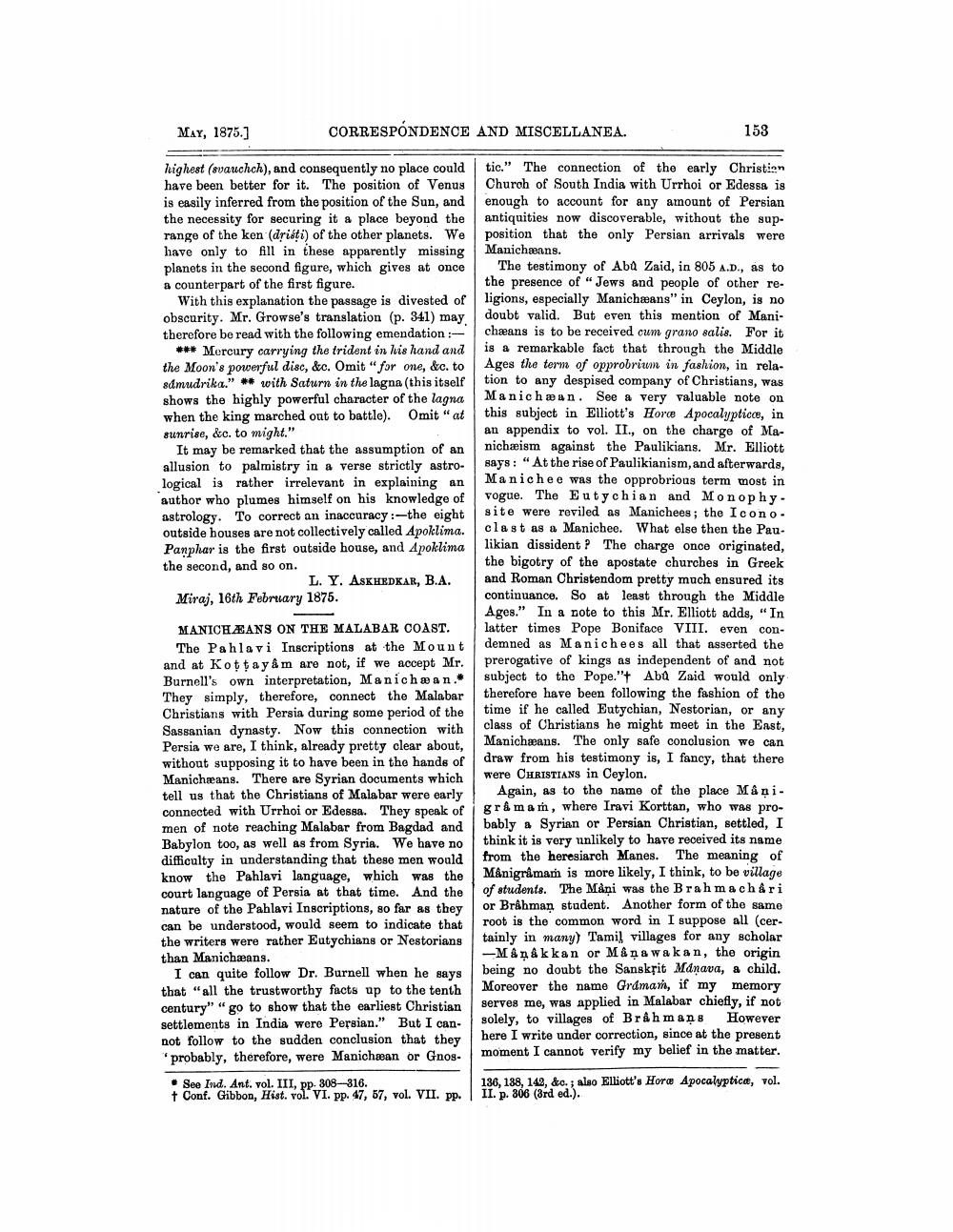________________
MAY, 1875.]
highest (svauchch), and consequently no place could have been better for it. The position of Venus is easily inferred from the position of the Sun, and the necessity for securing it a place beyond the range of the ken (dristi) of the other planets. We have only to fill in these apparently missing planets in the second figure, which gives at once a counterpart of the first figure.
With this explanation the passage is divested of obscurity. Mr. Growse's translation (p. 341) may therefore be read with the following emendation:--
CORRESPONDENCE AND MISCELLANEA.
*** Mercury carrying the trident in his hand and the Moon's powerful disc, &c. Omit "for one, &c. to samudrika."** with Saturn in the lagna (this itself shows the highly powerful character of the lagna when the king marched out to battle). Omit "at sunrise, &c. to might."
It may be remarked that the assumption of an allusion to palmistry in a verse strictly astrological is rather irrelevant in explaining an author who plumes himself on his knowledge of astrology. To correct an inaccuracy:-the eight outside houses are not collectively called Apoklima. Panphar is the first outside house, and Apoklima the second, and so on.
L. Y. ASKHEDKAR, B.A. Miraj, 16th February 1875.
MANICHEANS ON THE MALABAR COAST. The Pahlavi Inscriptions at the Mount and at Kottayam are not, if we accept Mr. Burnell's own interpretation, Manichæ an. They simply, therefore, connect the Malabar Christians with Persia during some period of the Sassanian dynasty. Now this connection with Persia we are, I think, already pretty clear about, without supposing it to have been in the hands of Manichæans. There are Syrian documents which tell us that the Christians of Malabar were early connected with Urrhoi or Edessa. They speak of men of note reaching Malabar from Bagdad and Babylon too, as well as from Syria. We have no difficulty in understanding that these men would know the Pahlavi language, which was the court language of Persia at that time. And the nature of the Pahlavi Inscriptions, so far as they can be understood, would seem to indicate that the writers were rather Eutychians or Nestorians than Manichæans.
I can quite follow Dr. Burnell when he says that "all the trustworthy facts up to the tenth century" "go to show that the earliest Christian settlements in India were Persian." But I cannot follow to the sudden conclusion that they 'probably, therefore, were Manichæan or Gnos
153
tic." The connection of the early Christian Church of South India with Urrhoi or Edessa is enough to account for any amount of Persian antiquities now discoverable, without the supposition that the only Persian arrivals were Manichæans.
See Ind. Ant. vol. III, pp. 308-316.
† Conf. Gibbon, Hist. vol. VI. pp. 47, 57, vol. VII. pp.
The testimony of Abu Zaid, in 805 A.D., as to the presence of "Jews and people of other religions, especially Manichæans" in Ceylon, is no doubt valid. But even this mention of Manichæans is to be received cum grano salis. For it is a remarkable fact that through the Middle Ages the term of opprobrium in fashion, in relation to any despised company of Christians, was Manichæan. See a very valuable note on this subject in Elliott's Hore Apocalyptice, in an appendix to vol. II., on the charge of Manichæism against the Paulikians. Mr. Elliott says: "At the rise of Paulikianism, and afterwards, Manichee was the opprobrious term most in vogue. The Eutychian and Monophy. site were reviled as Manichees; the Iconoclast as a Manichee. What else then the Paulikian dissident? The charge once originated, the bigotry of the apostate churches in Greek and Roman Christendom pretty much ensured its continuance. So at least through the Middle Ages." In a note to this Mr. Elliott adds, "In latter times Pope Boniface VIII. even condemned as Manichees all that asserted the prerogative of kings as independent of and not subject to the Pope."+ Abú Zaid would only therefore have been following the fashion of the time if he called Eutychian, Nestorian, or any class of Christians he might meet in the East, Manichæans. The only safe conclusion we can draw from his testimony is, I fancy, that there were CHRISTIANS in Ceylon.
Again, as to the name of the place Mânigram am, where Iravi Korttan, who was probably a Syrian or Persian Christian, settled, I think it is very unlikely to have received its name from the heresiarch Manes. The meaning of Manigramam is more likely, I think, to be village of students. The Mani was the Brahmachari or Brahman student. Another form of the same root is the common word in I suppose all (certainly in many) Tamil villages for any scholar -Manakkan or Manawakan, the origin. being no doubt the Sanskrit Manava, a child. Moreover the name Grámam, if my memory serves me, was applied in Malabar chiefly, if not However solely, to villages of Brahmans here I write under correction, since at the present moment I cannot verify my belief in the matter.
136, 138, 142, &c.; also Elliott's Hora Apocalyptica, vol. II. p. 306 (3rd ed.).




